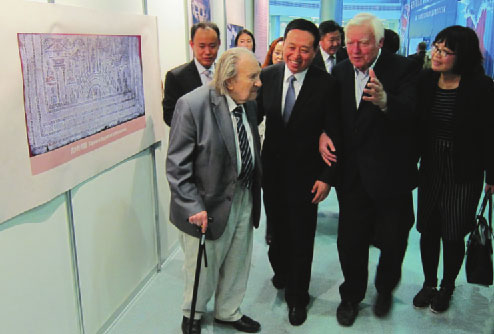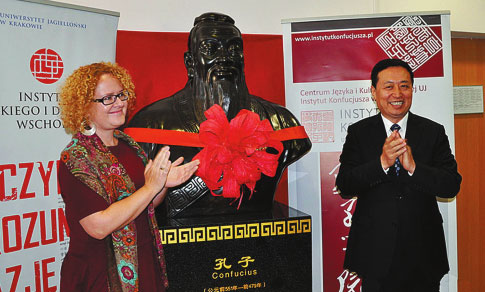Russian exhibit of ancient Chinese artworks
An exhibition of ancient Chinese carved stone rubbings from Shandong province held recently in St. Petersburg, Russia, has been hailed by organizers as an important promotion of Sino-Russia cultural exchanges.
The Shandong Stone Carving Arts Museum selected 47 rubbings for the exhibit, held Sept 30 to Oct 3 at the Lenexpo Exhibition Complex, choosing cultural treasures that told stories about farming, cooking, traveling, dancing and wars during the Han Dynasty (206 BC-220 AD).
They were displayed with photos, videos and illustrations to help visitors better understand the images on the stone reliefs.
The exhibition was unprecedented, both as the first event of its kind in Russia and as an example of art that transcends its simplicity, said Charkin Albert Serafimovich, chairman of the Saint Petersburg Union of Artists.
The exhibit also won praise from visitors for showcasing the unique charm of the ancient Chinese art form. The rubbings were framed in the same way Chinese paintings are mounted to better highlight the rubbings' traditional characteristics.
The exhibit, which reflected the Chinese peoples' love of life and respect for nature, showed how the rubbings played a crucial role in the development of modern painting, said Anatoli Pavlovich Levitin, a 93-year-old oil painter and vice-president of the Russian Academy of Arts.
Stone reliefs were common building decorations in ancient China, especially during the Han Dynasty. The carvings depicted nearly every aspect of social life and thus were dubbed "stone epics". They were an important building component of palaces, ancestral temples and tombs.
Shandong province is the birthplace of Han Dynasty stone reliefs. More than 10,000 stone reliefs carved during the dynasty have been found in China, including 4,500 discovered in Shandong.
The province also boasts most of China's ancient stone carvings, including more than 4,000 carvings made during and before the Tang Dynasty (AD 618-907). About 60 percent of the country's Han Dynasty monument inscriptions were found in Qufu, Jining and Tai'an in the province.
The ancient stone carvings in Shandong province, based on their shapes, are mainly divided into stele, stone reliefs, cliff inscriptions, epigraphs and statues.
In recent years, the Shangdong provincial government and its cultural bureaus have organized an annual batch of overseas cultural exhibitions, with themes such as Confucian culture, ancient Buddha statues, and paintings and calligraphies, to raise the province's reputation in the field of cultural relics both at home and abroad.
They have hosted more than 20 ancient carved stone rubbing exhibitions in countries and regions, including Germany and South Korea as well as China's Taiwan. The most recent one was held in Romania on Oct 5.
"Hosting such cultural exchanges more frequently aims to bring the ancient cultural relics alive and let them spread Shandong's profound ancient culture across the world," said Xie Zhixiu, head of the Shandong Provincial Administration of Cultural Heritage.
The Shandong government also donated a statue of Confucius to the Confucius Institute at Jagiellonian University in Krakow, Poland, on Oct 3.
"We hope to promote the Chinese culture on a larger scale with the help of Jagiellonian University, the most ancient one in Poland," said Sun Shougang, head of the Shandong Foreign Cultural Exchange Association.
"Studies of Confucius and his teachings are an important approach to understanding the spiritual world of the modern Chinese and the character of the nation, which will also help promote exchanges and cooperation between China and 16 Central and Eastern European countries," Sun said.
"In Poland, people now have an ever increasing interest in learning the Chinese culture and the language, so cultural events like the donation of a Confucius statue would have great significance for exchanges and cooperation in various fields between China and Poland," said Andrzej Dudek, deputy dean of the International and Political Studies department at Jagiellonian University.
haonan@chinadaily.com.cn
|
Sun Shougang (second from left), head of the Shandong Foreign Cultural Exchange Association, meets Russian artists during a recent exhibition of ancient Chinese carved stone rubbings from the province in Russia's Saint Petersburg. Provided to China Daily |
|
The Shandong government donates a statue of Confucius to the Confucius Institute at Jagiellonian University in Krakow, Poland, on Oct 3. Provided to China Daily |
(China Daily 10/10/2015 page10)
















